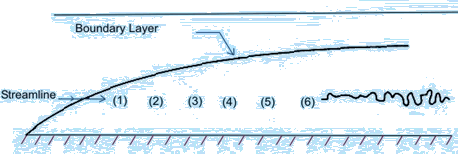|
Several Events Of Transition
-
Transitional flow consists of several events as shown in Fig. 31.8. Let us consider the events one after another.
1. Region of instability of small wavy disturbances-
Consider a laminar flow over a flat plate aligned with the flow direction (Fig. 31.8).
- In the presence of an adverse pressure gradient, at a high Reynolds number (water velocity approximately 9-cm/sec), two-dimensional waves appear.
- These waves are called Tollmien-Schlichting wave( In 1929, Tollmien and Schlichting predicted that the waves would form and grow in the boundary layer).
- These waves can be made visible by a method known as tellurium method.
2. Three-dimensional waves and vortex formation-
- Disturbances in the free stream or oscillations in the upstream boundary layer can generate wave growth, which has a variation in the span wise direction.
- This leads an initially two-dimensional wave to a three-dimensional form.
- In many such transitional flows, periodicity is observed in the span wise direction.
- This is accompanied by the appearance of vortices whose axes lie in the direction of flow.
3. Peak-Valley development with streamwise vortices-
- As the three-dimensional wave propagates downstream, the boundary layer flow develops into a complex stream wise vortex system.
- Within this vortex system, at some spanwise location, the velocities fluctuate violently .
- These locations are called peaks and the neighbouring locations of the peaks are valleys (Fig. 31.9).
4. Vorticity concentration and shear layer development-
At the spanwise locations corresponding to the peak, the instantaneous streamwise velocity profiles demonstrate the following
- Often, an inflexion is observed on the velocity profile.
- The inflectional profile appears and disappears once after each cycle of the basic wave.
5. Breakdown-
The instantaneous velocity profiles produce high shear in the outer region of the boundary layer.
- The velocity fluctuations develop from the shear layer at a higher frequency than that of the basic wave.
- These velocity fluctuations have a strong ability to amplify any slight three-dimensionality, which is already present in the flow field.
- As a result, a staggered vortex pattern evolves with the streamwise wavelength twice the wavelength of Tollmien-Schlichting wavelength .
- The span wise wavelength of these structures is about one-half of the stream wise value.
- The high frequency fluctuations are referred as hairpin eddies.
This is known as breakdown.
6. Turbulent-spot development-
- The hairpin-eddies travel at a speed grater than that of the basic (primary) waves.
- As they travel downstream, eddies spread in the spanwise direction and towards the wall.
- The vortices begin a cascading breakdown into smaller vortices.
- In such a fluctuating state, intense local changes occur at random locations in the shear layer near the wall in the form of turbulent spots.
- Each spot grows almost linearly with the downstream distance.
The creation of spots is considered as the main event of transition .

Fig. 31.8 Sequence of event involved in transition

Fig. 31.9 Cross-stream view of the streamwise vortex system
|